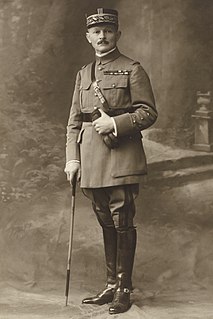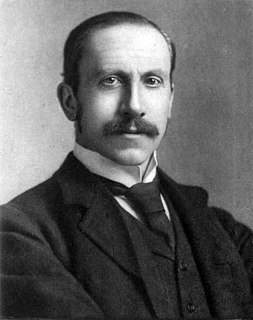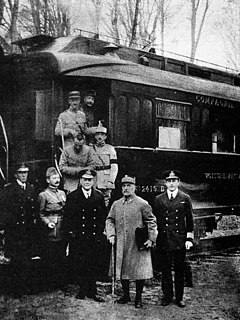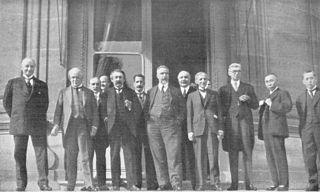Related Research Articles

The Treaty of Versailles was the most important of the peace treaties that brought World War I to an end. The Treaty ended the state of war between Germany and the Allied Powers. It was signed on 28 June 1919 in the Palace of Versailles, exactly five years after the assassination of Archduke Franz Ferdinand, which led to the war. The other Central Powers on the German side signed separate treaties. Although the armistice, signed on 11 November 1918, ended the actual fighting, it took six months of Allied negotiations at the Paris Peace Conference to conclude the peace treaty. The treaty was registered by the Secretariat of the League of Nations on 21 October 1919.

Georges Eugène Benjamin Clemenceau was a French statesman who served as Prime Minister of France from 1906 to 1909 and again from 1917 until 1920. A key figure of the Independent Radicals, he was a strong advocate of separation of church and state, amnesty of the Communards exiled to New Caledonia, as well as opposition to colonisation. Clemenceau, a physician turned journalist, played a central role in the politics of the Third Republic, most notably successfully leading France through the end of the First World War.

Maxime Weygand was a French military commander in World War I and World War II.

The Fourteen Points was a statement of principles for peace that was to be used for peace negotiations in order to end World War I. The principles were outlined in a January 8, 1918 speech on war aims and peace terms to the United States Congress by President Woodrow Wilson. However, his main Allied colleagues were skeptical of the applicability of Wilsonian idealism.

The Pact of Steel, known formally as the Pact of Friendship and Alliance between Germany and Italy, was a military and political alliance between Italy and Germany.

The Paris Peace Conference was the formal meeting in 1919 and 1920 of the victorious Allies after the end of World War I to set the peace terms for the defeated Central Powers. Dominated by the leaders of Britain, France, the United States and Italy, it resulted in five treaties that rearranged the map of Europe and parts of Asia, Africa and the Pacific Islands and imposed financial penalties. Germany and the other losing nations had no voice which gave rise to political resentments that lasted for decades.

Ferdinand Foch was a French general and military theorist who served as the Supreme Allied Commander during the First World War. An aggressive, even reckless commander at the First Marne, Flanders and Artois campaigns of 1914–1916, Foch became the Allied Commander-in-Chief in late March 1918 in the face of the all-out German spring offensive, which pushed the Allies back using fresh soldiers and new tactics that trenches could not contain. He successfully coordinated the French, British and American efforts into a coherent whole, deftly handling his strategic reserves. He stopped the German offensive and launched a war-winning counterattack. In November 1918, Marshal Foch accepted the German cessation of hostilities and was present at the Armistice of 11 November 1918.

Alfred Milner, 1st Viscount Milner, was an English statesman and colonial administrator who played a role in the formulation of British foreign and domestic policy between the mid-1890s and early 1920s. From December 1916 to November 1918, he was one of the most important members of Prime Minister David Lloyd George's War Cabinet.

The Armistice of 11 November 1918 was the armistice signed at Le Francport near Compiègne that ended fighting on land, sea and air in World War I between the Allies and their last remaining opponent, Germany. Previous armistices had been agreed with Bulgaria, the Ottoman Empire and the Austro-Hungarian Empire. Also known as the Armistice of Compiègne from the place where it was officially signed at 5:45 a.m. by the Allied Supreme Commander, French Marshal Ferdinand Foch, it came into force at 11:00 a.m. Paris time on 11 November 1918 and marked a victory for the Allies and a defeat for Germany, although not formally a surrender.

The causes of World War II, a global war from 1939 to 1945 that was the deadliest conflict in human history, have been given considerable attention by historians from many countries who studied and understood them. The immediate precipitating event was the invasion of Poland by Nazi Germany on September 1, 1939, and the subsequent declarations of war on Germany made by Britain and France, but many other prior events have been suggested as ultimate causes. Primary themes in historical analysis of the war's origins include the political takeover of Germany in 1933 by Adolf Hitler and the Nazi Party; Japanese militarism against China, which led to the Second Sino-Japanese War; Italian aggression against Ethiopia, which led to the Second Italo-Ethiopian War and Germany's initial success in negotiating the Molotov–Ribbentrop Pact with the Soviet Union to divide the territorial control of Eastern Europe between them.
Article 231, often known as the War Guilt Clause, was the opening article of the reparations section of the Treaty of Versailles, which ended the First World War between the German Empire and the Allied and Associated Powers. The article did not use the word "guilt" but it served as a legal basis to compel Germany to pay reparations for the war.

Concluded on 30 October 1918 and taking effect at noon the next day, the Armistice of Mudros ended hostilities in the Middle Eastern theatre between the Ottoman Empire and the Allies of World War I. It was signed by the Ottoman Minister of Marine Affairs Rauf Bey and British Admiral Somerset Arthur Gough-Calthorpe, on board HMS Agamemnon in Moudros harbor on the Greek island of Lemnos.

The Supreme War Council was a central command based in Versailles that coordinated the military strategy of the principal Allies of World War I: Britain, France, Italy, the US and Japan. It was founded in 1917 after the Russian revolution and with Russia's withdrawal as an ally imminent. The council served as a forum for preliminary discussions of potential armistice terms, later for peace treaty settlement conditions, and it was succeeded by the Conference of Ambassadors in 1920.
The military alliance between the United Kingdom and Poland was formalised by the Anglo-Polish Agreement in 1939, with subsequent addenda of 1940 and 1944, for mutual assistance in case of a military invasion from Germany, as specified in a secret protocol.

The remilitarization of the Rhineland began on 7 March 1936, when German military forces entered the Rhineland, which directly contravened the Treaty of Versailles and the Locarno Treaties. Neither France nor Britain was prepared for a military response, so they did not act. After 1939 commentators often said that a strong military move in 1936 might have ruined Hitler's expansionist plans. However, recent historiography agrees that both public and elite opinion in Britain and France strongly opposed a military intervention, and neither had an army prepared to move in.
The Franco-Soviet Treaty of Mutual Assistance was a bilateral treaty between France and the Soviet Union with the aim of enveloping Nazi Germany in 1935 to reduce the threat from Central Europe. It was pursued by Maxim Litvinov, the Soviet foreign minister, and Louis Barthou, the French foreign minister, who was assassinated in October 1934, before negotiations had been finished. His successor, Pierre Laval, was sceptical of the desirability and of the value of an alliance with the Soviet Union. However, after the declaration of German rearmament in March 1935, the French government forced the reluctant foreign minister to complete the arrangements with Moscow that Barthou had begun.

The Big Four or the Four Nations refer to the four top Allied powers of World War I and their leaders who met at the Paris Peace Conference in January 1919. The Big Four is also known as the Council of Four. It was composed of Georges Clemenceau of France, David Lloyd George of the United Kingdom, Vittorio Emanuele Orlando of Italy, and Woodrow Wilson of the United States.

The Doullens Conference was held in Doullens, France, on 26 March 1918 between French and British military leaders and governmental representatives during World War I. Its purpose was to better co-ordinate their armies' operations on the Western Front in the face of a dramatic advance by the German Army which threatened a breakthrough at that moment of their lines during the War's final year.

German–Soviet Axis talks occurred in October and November 1940 concerning the Soviet Union's potential entry as a fourth Axis Power during World War II. The negotiations, which occurred during the era of the Molotov–Ribbentrop Pact, included a two-day conference in Berlin between Soviet Foreign Minister Vyacheslav Molotov and Adolf Hitler and German Foreign Minister Joachim von Ribbentrop. The talks were followed by both countries trading written proposed agreements.
The United Kingdom declared war on Germany on 3 September 1939, two days after Germany invaded Poland. France also declared war on Germany later the same day.